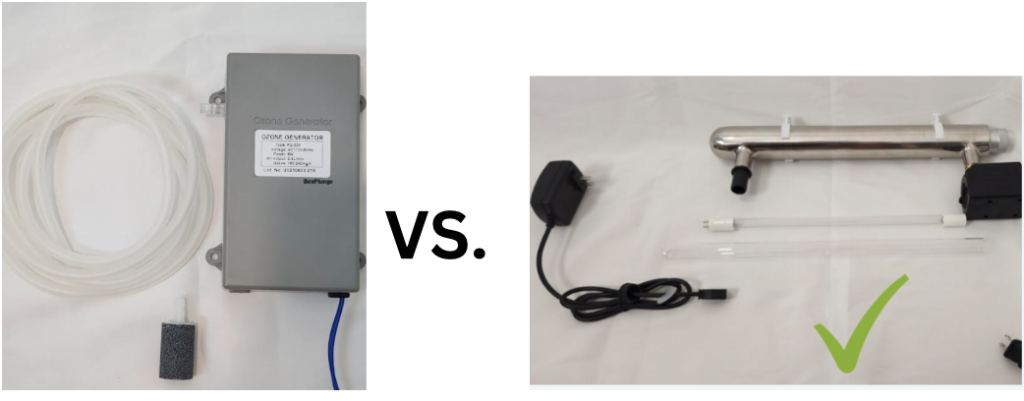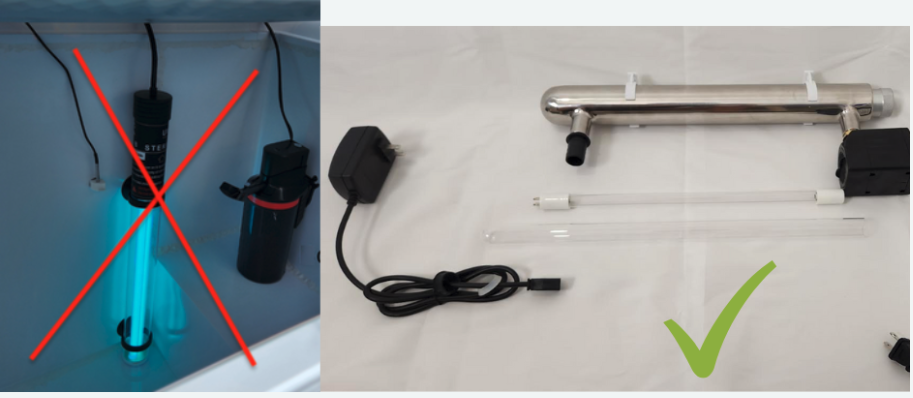UV light VS Ozone Generator for your cold plunge

The benefits of deliberate cold exposure are unquestionable but for you to really enjoy the plunge you should take care of the equipment. Here are the best sanitation methods for your cold plunge:
Table of content:
What is water sanitation or cleaning and why is it important?
Sanitation in cold plunge pools is vital for:
- Preventing disease spread, as unsanitized pools can become breeding grounds for harmful microorganisms causing various illnesses.
- Inhibits algae growth, thereby avoiding water discoloration, unpleasant odors, and unsafe slippery surfaces.
- Enhances user comfort and safety by reducing the likelihood of skin and eye irritation. Additionally, proper water sanitation helps extend the lifespan of pool equipment by preventing corrosion and damage caused by dirty water.
Therefore, sanitation protocols typically incorporate sanitizing chemicals, ozone generators, or UV light, coupled with regular pH level monitoring and adjustment. I’ll leave chemical sanitization (which is often considered optional) for another post. The two best sanitation methods for your cold plunge are:
An ozone generator works in a fascinatingly efficient way to purify your cold plunge water. It operates by taking in oxygen, then using an electrical charge to add an extra oxygen atom, transforming it from O2 to O3, which is ozone. This form of oxygen is highly reactive, making it a very effective sanitizer. Once introduced into the water, the ozone rapidly interacts with organic matter such as bacteria and viruses. This interaction, called oxidation, involves ozone breaking down the cell walls of the pathogens, essentially destroying them. This not only neutralizes harmful microorganisms but also helps in breaking down other contaminants. The result is cleaner, healthier water, achieved in a way that’s both environmentally friendly and highly effective.
UV-C light itself works by inactivating harmful microorganisms – when bacteria, viruses, or other pathogens are exposed to UV-C radiation, their DNA or RNA is damaged, preventing them from replicating and causing infection. Encasing UV-C light within a 304 stainless steel chamber isn’t just about style; it’s a smart move that substantially improves the system’s efficiency. This isn’t any ordinary metal; 304 stainless steel is renowned for its high corrosion resistance, ensuring durability in various water conditions. But here’s the exciting part. The shiny interior of this stainless-steel casing acts as a mirror, reflecting UV-C rays to increase their contact with the water. This amplifies the sanitizing power, leading to more harmful microorganisms getting zapped! It all works in tandem with a reliable pump that keeps water flowing smoothly into the steel chamber, past the UV-C light, and back into the cold plunge.
Note: Failing to enclose the UVC light will not only diminish its sanitation properties but it will also significantly degrade your cold plunge materials.

| UVC Light | Ozone | |
| Evenly killing all bacteria | 80 | 95 |
| Keeping water clear | 90 | 90 |
| Maintenance | 85 | 85 |
| Indoor Friendly | 98 | 70 |
Ozone:
- Pros:
- Complete Disinfection: While UV-C light is effective in inactivating many types of microorganisms, it primarily works when the water is flowing through the UV chamber. In contrast, ozone can sanitize the entire volume of water in a system, including parts that UV-C might not reach.
- Fewer Chemical Additives: Ozone, being a powerful oxidizer, reduces the need for additional chemical sanitizers, some of which can cause adverse reactions or require careful management. UV-C, while effective, often works best in conjunction with additional sanitizing agents.
- Breakdown of Organic Matter: Ozone is not just an antimicrobial agent; it also helps to break down organic matter in the water, like oils or lotions, which can make water cloudy or cause unpleasant odors. While UV-C light is effective against microorganisms, it doesn’t have the same impact on these other types of contaminants.
- Cons:
- Equipment and Installation Costs: Ozone generators can be more expensive upfront than other sanitation methods like UV-C systems. They also require professional installation and regular maintenance, which adds to the overall cost.
- Off-Gassing Concerns: Ozone is a powerful oxidizer and can be harmful to breathe in large quantities. If the off-gassing is not correctly managed, it can potentially pose a risk to health, especially in indoor environments.
- Potential Material Damage: The strength of ozone as an oxidizer, while beneficial for sanitization, can potentially have negative effects on certain materials over time. For example, certain types of plastics, rubber, and other materials can degrade faster under prolonged exposure to ozone. This could lead to the need for more frequent maintenance and replacement of parts in a cold plunge pool system, adding to long-term costs.
UV-C light:
Pros:
- Continuous Disinfection: UV-C light provides continuous disinfection as long as the water is circulating. This means that every time the water passes through the UV chamber, microorganisms are being inactivated, ensuring that sanitized water is consistently reintroduced into the pool.
- No Chemical Residues: Unlike certain sanitizing chemicals or ozone, UV-C light leaves no residues in the water. It acts directly on the microorganisms, without altering the water’s chemical composition, which means there’s no risk of byproducts or alterations to water balance.
- 100% indoors friendly: does not produce harmful gasses or residues, making it a safer option for indoor use.
- Safe for Pool Materials: UV-C systems are generally safe for all types of pool materials. They don’t contribute to wear and tear, unlike chemical sanitizers or ozone, which can cause degradation of certain materials over time. This can result in lower long-term maintenance costs.
Cons:
- Surface Limitation: Even if the UVC light is enclosed in 304 SS, the light can only disinfect the water that directly passes by or through the enclosure. Unlike ozone, which can be dispersed throughout the entire volume of the pool, UVC’s disinfecting capability is limited to its immediate vicinity.
- Organic Matter Disintegration: UVC light is less effective at breaking down organic matter compared to ozone. This could lead to a buildup of organic material in the water over time, which may necessitate more frequent water changes or additional filtration systems.
Conclusion:
Both ozone and enclosed UV-C light are effective sanitation methods for cold plunge pools, each with its own set of advantages and considerations.
Ozone offers complete disinfection, sanitizing the entire volume of water and breaks down organic matter. But comes with potential off-gassing concerns, and the possibility of material damage over time.
Enclosed UV-C light provides continuous disinfection without chemical residues and is safe for your cold plunge material. It is 100% indoors friendly, making it a safer option for indoor use. However, its disinfecting capability is limited to the water that directly passes by or through the enclosure, and it may be less effective at breaking down organic matter.
In terms of evenly killing all bacteria ozone scored higher. Maintenance is generally comparable for both systems. However, ozone has the potential advantage of breaking down organic matter, while enclosed UV-C light has the benefit of being safer for indoor use and posing no risk to pool materials.
Ultimately, the choice between ozone and enclosed UV-C light depends on factors such as budget, mounting capabilities, specific requirements, and preference for continuous disinfection versus broader reach in sanitizing. Proper maintenance and adherence to recommended protocols are key to ensuring the effectiveness and longevity of either sanitation method, allowing you to fully enjoy the benefits of deliberate cold exposure in your cold plunge pool.